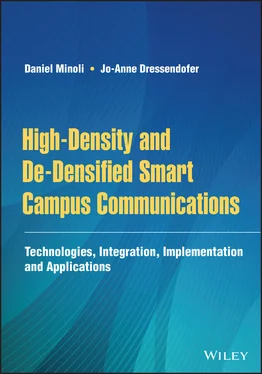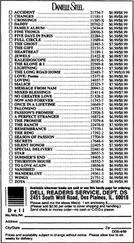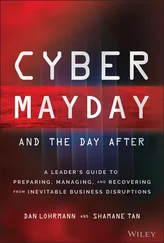1 Cover
2 Title Page
3 Copyright Page
4 Dedication Page
5 Preface
6 About the Authors
7 Acknowledgments
8 1 Background and Functional Requirements for High‐Density Communications 1.1 BACKGROUND 1.2 REQUIREMENTS FOR HIGH‐DENSITY COMMUNICATIONS 1.3 PANDEMIC‐DRIVEN SOCIAL DISTANCING 1.4 THE CONCEPT OF A WIRELESS SuperNetwork REFERENCES
9 2 Traditional WLAN Technologies 2.1 OVERVIEW 2.2 WLAN STANDARDS 2.3 WLAN BASIC CONCEPTS 2.4 HARDWARE ELEMENTS 2.5 KEY IEEE 802.11AC MECHANISMS 2.6 BRIEF PREVIEW OF IEEE 802.11AX REFERENCES
10 3 Traditional DAS Technologies 3.1 OVERVIEW 3.2 FREQUENCY BANDS OF CELLULAR OPERATION 3.3 DISTRIBUTED ANTENNA SYSTEMS (DASs) REFERENCES
11 4 Traditional Sensor Networks/IoT Services 4.1 OVERVIEW AND ENVIRONMENT 4.2 ARCHITECTURAL CONCEPTS 4.3 WIRELESS TECHNOLOGIES FOR THE IoT 4.4 EXAMPLES OF SEVEN‐LAYER IoT PROTOCOL STACKS 4.5 GATEWAY‐BASED IoT OPERATION 4.6 EDGE COMPUTING IN THE IoT ECOSYSTEM 4.7 SESSION ESTABLISHMENT EXAMPLE 4.8 IoT SECURITY REFERENCES
12 5 Evolved Campus Connectivity 5.1 ADVANCED SOLUTIONS 5.2 VOICE OVER Wi‐Fi (VoWi‐Fi) 5.3 5G TECHNOLOGIES 5.4 IoT 5.5 5G DAS SOLUTIONS 5.6 INTEGRATED SOLUTIONS REFERENCES
13 6 De‐densification of Spaces and Work Environments 6.1 OVERVIEW 6.2 BASIC APPROACHES 6.3 RTLS METHODOLOGIES AND TECHNOLOGIES 6.4 STANDARDS 6.5 APPLICATIONS REFERENCES
14 7 UWB‐Based De‐densification of Spaces and Work Environments 7.1 REVIEW OF UWB TECHNOLOGY 7.2 CARRIAGE OF INFORMATION IN UWB 7.3 UWB STANDARDS 7.4 IoT APPLICATIONS FOR UWB 7.5 UWB APPLICATIONS FOR SMART CITIES AND FOR REAL‐TIME LOCATING SYSTEMS 7.6 OSD/ODCMA APPLICATIONS REFERENCES
15 8 RTLSs and Distance Tracking Using Wi‐Fi, Bluetooth, and Cellular Technologies 8.1 OVERVIEW 8.2 RF FINGERPRINTING METHODS 8.3 Wi‐Fi RTLS APPROACHES 8.4 BLE 8.5 CELLULAR APPROACHES 8.6 SUMMARY REFERENCES
16 9 Case Study of an Implementation and Rollout of a High‐Density High‐Impact Network 9.1 THURGOOD MARSHALL BWI AIRPORT DESIGN REQUIREMENTS 9.2 OVERVIEW OF THE FINAL DESIGN
17 10 The Age of Wi‐Fi and Rise of the Wireless SuperNetwork (WiSNET) 10.1 WHAT PRECEDED THE WiSNET 10.2 WHAT COMES NEXT 10.3 THE SUPER‐INTEGRATION CONCEPT OF A WIRELESS SUPERNETWORK (WiSNET) 10.4 THE MULTIDIMENSIONALITY OF A SUPERNETWORK (WiSNET) 10.5 THE GENESIS OF THE WiSNET CONCEPT DEFINED IN THIS TEXT 10.6 THE DEFINITION AND CHARACTERIZATION OF A WiSNET 10.7 ECONOMIC ADVANTAGES OF A WiSNET SYSTEM 10.8 5G SLICE CAPABILITIES 10.9 CONCLUSION REFERENCES
18 Index
19 End User License Agreement
1 Chapter 1 TABLE 1.1 Key Performance Indicators HDC Key Performance Indicators (KPIs) TABLE 1.2 HDC KPIs for Airports TABLE 1.3 Top US Airports – Actual and Heuristic Data Shown TABLE 1.4 Largest US Football Stadiums TABLE 1.5 Top Convention Centers in the United States TABLE 1.6 Top Amusement Parks in the United States TABLE 1.7 Enrolments at Largest US Districts TABLE 1.8 Example of School Demographics (NYC) TABLE 1.9 Top Subway and Rapid Transit Systems in the United States TABLE 1.10 HDC KPIs for Airports
2 Chapter 2 TABLE 2.1 Comparison of key features of WLANs/WPANs [3] TABLE 2.2 IEEE 802.11 Active Projects at Press Time TABLE 2.3 Inter‐frame Space Types TABLE 2.4 Basic Error Coding Schemes TABLE 2.5 5 GHz Wi‐Fi Frequencies TABLE 2.6 802.11 Cheat Sheet TABLE 2.7 Modulation and Coding Schemes for Single Spatial Stream
3 Chapter 3 TABLE 3.1 Bandwidths for LTE Systems in North America TABLE 3.2 Satellite Bands, Generalized View per IEEE Standard 521‐1984 TABLE 3.3 Performance Measures, eMBB/5GTABLE 3.4 Frequency Range 1 (FR1)TABLE 3.5 Frequency Range 2TABLE 3.6 CPRI Rates
4 Chapter 4TABLE 4.1 IoT Deployment SynthesisTABLE 4.2 IoT Systems and Methods to Support the Connected EcosystemTABLE 4.3 Partial Listing of Key IoT RAsTABLE 4.4 Wireless Communications Technologies that are Typically Used in IoT Sys...TABLE 4.5 Comparison of Key Fog/Edge and Core Wireless Technologies Applicable to...TABLE 4.6 Features of Some Key Protocol StacksTABLE 4.7 Comparison of Key FeaturesTABLE 4.8 CIA Security GoalsTABLE 4.9 User Plane Confidentiality Protection Mechanisms for LTETABLE 4.10 User Plane Integrity Protection Mechanisms for LTETABLE 4.11 OSiRM‐assisted Transition from “As Is” to a “To Be” Environment...
5 Chapter 5TABLE 5.1 Higher Efficiency and Capacity Features Under 802.11ax/Wi‐Fi 6TABLE 5.2 802.11ax Changes Compared with 802.11acTABLE 5.3 Total Number of RUs by Channel BandwidthTABLE 5.4 Key EPC Architecture Elements
6 Chapter 6TABLE 6.1 Occupancy Aspects that are Important to OSD/ODCMA PoliciesTABLE 6.2 Taxonomy of Occupancy Detection Systems, with Focus on RTLSsTABLE 6.3 RTLS ComparisonTABLE 6.4 Possible RTLS Applications in Smart CitiesTABLE A.1 Basic Terms and Concepts Relative to Positioning TechnologiesTABLE A.2 Basic RFID Terms and Concepts Relative to Positioning Technologies
7 Chapter 8TABLE 8.1 Basic best practices of overlay Wi‐Fi‐based RTLSs (summarized from [21]...TABLE 8.2 Bluetooth Protocol VersionsTABLE 8.3 Additional comparison of technologies [57]TABLE 8.4 Overall comparison of sensor technologies for RTLSs
8 Chapter 9TABLE 9.1 MyBWI‐FI technology planTABLE 9.2 DAS Requirements for the BWI Airport
9 Chapter 10TABLE 10.1 Plethora of Players at BWI – In a WiSNET, All of These Are Managed by ...TABLE 10.2 Technical Characterization of a WiSNET
1 Chapter 1 FIGURE 1.1 Requirements bouquet. FIGURE 1.2 A gate area at Fort Lauderdale‐Hollywood International Airport is... FIGURE 1.3 Inventory of US buildings. FIGURE 1.4 Heuristic model for office space allocation. FIGURE 1.5 Infection and casualty data from the COVID‐19 Dashboard by the Ce... FIGURE 1.6 Pandemic impact on airline travel in the Fall of 2020. FIGURE 1.7 A pictorial view of an RTLS environment [50]. FIGURE 1.8 Generic RTLS system concept. FIGURE 1.9 De‐densified (heuristic model). FIGURE 1.10 INET‐v6: a Wireless SuperNetwork (WiSNET).
2 Chapter 2 FIGURE 2.1 Example of a WLAN (MIMO case). FIGURE 2.2 Block diagram of a WLAN device (example). FIGURE 2.3 A general MIMO system (after [12]). FIGURE 2.4 Example of PHY transmit procedure [2]. FIGURE 2.5 Inter‐frame Space relationships [2]. FIGURE 2.6 Carrier Sense Multiple Access/Collision Avoidance‐based frame tra... FIGURE 2.7 Distributed MIMO communication with beamforming [20]. FIGURE 2.8 SU‐MIMO versus MU‐MIMO. FIGURE 2.9 5GHz spectrum usability for IEEE 802.11ac LANs. FIGURE 2.10 Space–time block coding [2].
3 Chapter 3 FIGURE 3.1 Basic cellular and DAS setup. FIGURE 3.2 Examples of base station architectures. Top: traditional. Bottom:... FIGURE 3.3 Hoteling concept for RRUs. FIGURE 3.4 Frequency reuse [11]. FIGURE 3.5 Block diagram depicting architecture of a typical LTE/EPC environ... FIGURE 3.6 CBRS spectrum.FIGURE 3.7 Example of a multi‐antenna transmission embodiment having multipl...FIGURE 3.8 General DAS concept [37].FIGURE 3.9 A DAS system using digital remote antenna units [38].FIGURE 3.10 In‐building installation of a DAS [39].FIGURE 3.11 BS‐to‐HEU‐RAU connectivity (partially based on [40]).FIGURE 3.12 Illustrative example of carrier‐specific DAS [5].FIGURE 3.13 Illustrative example of carrier‐specific DAS used to better supp...FIGURE 3.14 Possible DAS arrangement for outdoor coverage in 5G environments...FIGURE 3.15 More detailed view of the DAS: two perspectives [2, 39].FIGURE 3.16 RRH sections.FIGURE 3.17 Fronthaul and backhaul.
4 Chapter 4FIGURE 4.1 A logical view of an IoT ecosystem.FIGURE 4.2 Applications scope of IoT/CPS (examples).FIGURE 4.3 Example of IoT ecosystem [50].FIGURE 4.4 OSiRM: open systems IoT reference model (transaction stack).FIGURE 4.5 Typical wireless technologies usable in the IoT context.FIGURE 4.6 The pre‐5G and the 5G IoT connectivity ecosystem.FIGURE 4.7 Example of communication systems in IoT with local aggregation [6...FIGURE 4.8 WAN/LPWAN IoT environment [55].FIGURE 4.9 Dual‐mode systems.FIGURE 4.10 Support of LTE‐M and NB‐IoT under 5G.FIGURE 4.11 Key IoT protocols in a full stack.FIGURE 4.12 The UPnP process for device control.FIGURE 4.13 Example of gateway performing a “bridging” function between non‐...FIGURE 4.14 Typical networking arrangement for smart home services where an ...FIGURE 4.15 Networking arrangement for smart home services where an IoT edge...FIGURE 4.16 IoT Session establishment example [121].
Читать дальше












